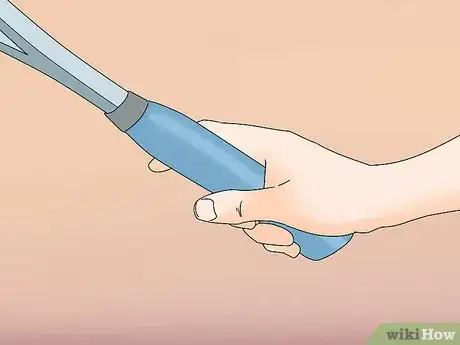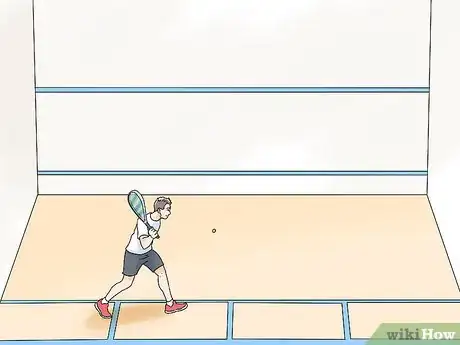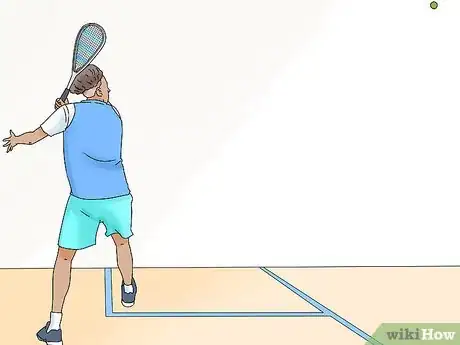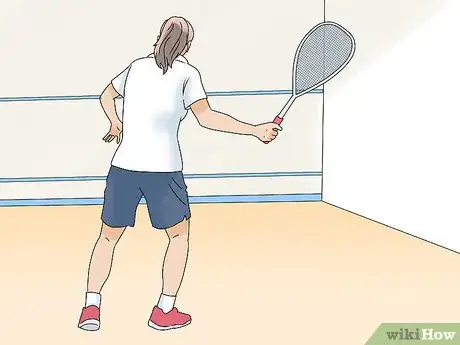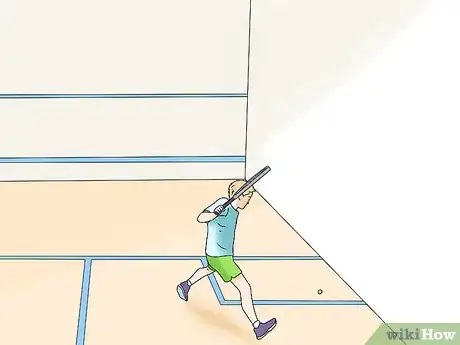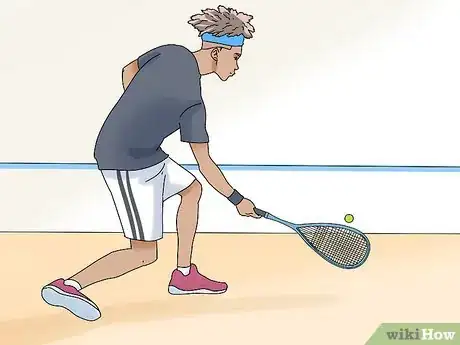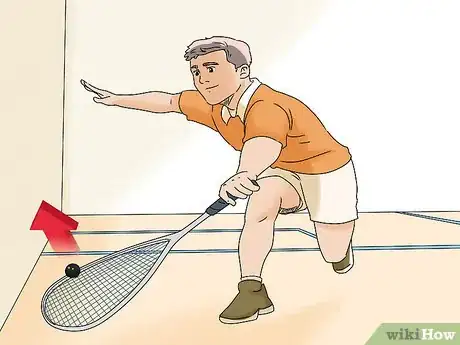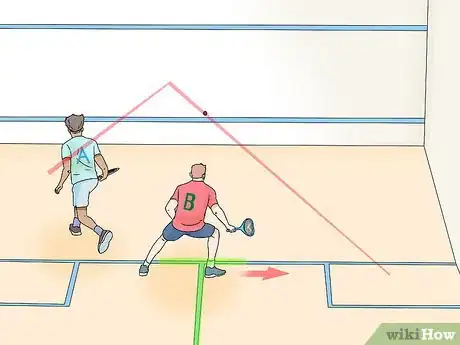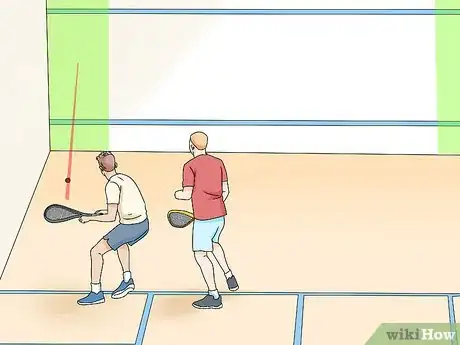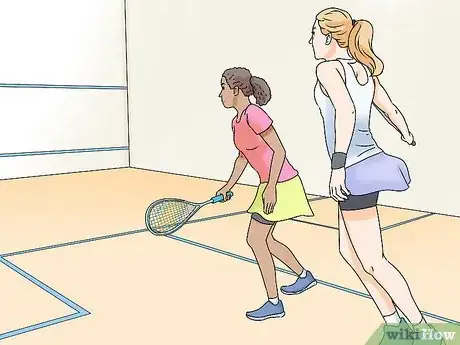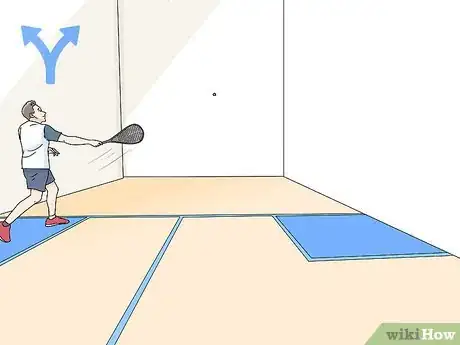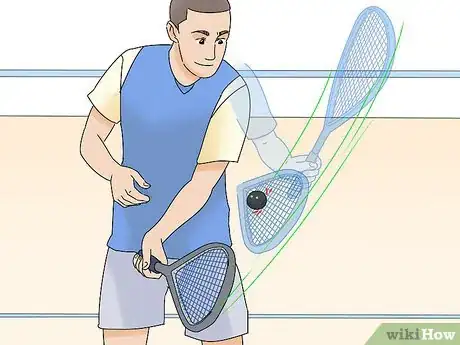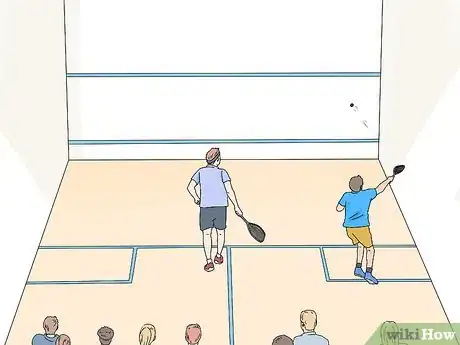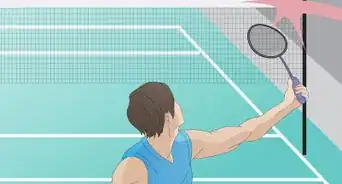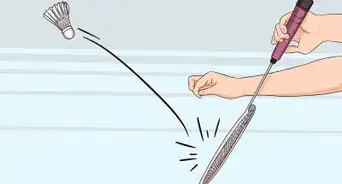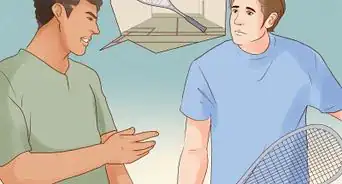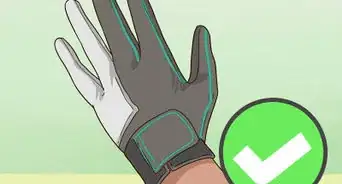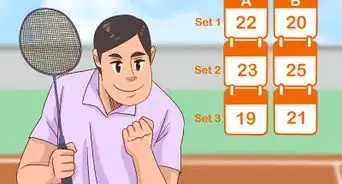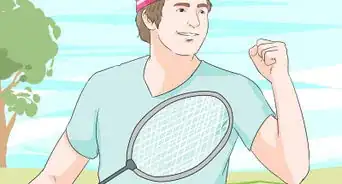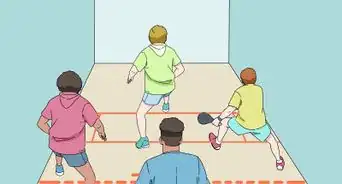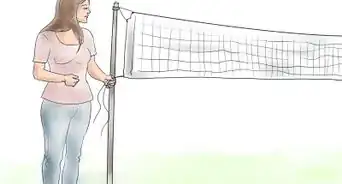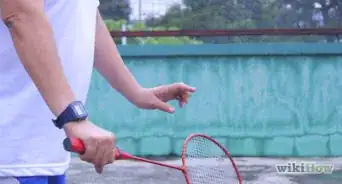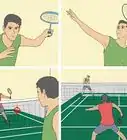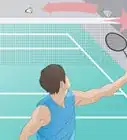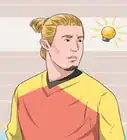This article was co-authored by wikiHow staff writer, Eric McClure. Eric McClure is an editing fellow at wikiHow where he has been editing, researching, and creating content since 2019. A former educator and poet, his work has appeared in Carcinogenic Poetry, Shot Glass Journal, Prairie Margins, and The Rusty Nail. His digital chapbook, The Internet, was also published in TL;DR Magazine. He was the winner of the Paul Carroll award for outstanding achievement in creative writing in 2014, and he was a featured reader at the Poetry Foundation’s Open Door Reading Series in 2015. Eric holds a BA in English from the University of Illinois at Chicago, and an MEd in secondary education from DePaul University.
There are 14 references cited in this article, which can be found at the bottom of the page.
This article has been viewed 70,859 times.
Learn more...
Squash is a fast-paced game played in an enclosed room, called a squash court. It is a one-on-one game, and is similar to tennis in the sense that you strike a ball with a racquet. To become a squash champion, you’ll need to master the basics of the game by working on your grip, footwork, and ball control. You’ll also need to practice using different kinds of shots, like the straight drive, lob, and drop shot, to out-maneuver your opponent on the floor. You can improve your mechanics and repertoire of shots by practicing frequently. With enough hard work and dedication, anyone can become a champion!
Steps
Mastering the Fundamentals
-
1Hold the racquet firmly like you’re shaking someone’s hand. Place your dominant hand in the middle of your racquet’s grip tape with the palm facing the direction that you’re swinging it. Wrap your thumb over the top and point your index finger towards the top of the racquet. Wrap your bottom three fingers around the bottom of the handle.[1]
- Don’t grip your racquet too hard or you’ll struggle to control it while you’re swinging it.
- If your grip isn’t firm enough, you’ll lose power in your swing.
-
2Serve the ball by swinging through it from the serving box. Serving is an essential element of mastering the game of squash. Start with your back foot in the serving box and your front foot in the front court. Lob the ball out and away from you at shoulder-length with your nondominant hand. As the ball is just about to start falling in mid-air, swing your racquet hard to strike the ball against the wall towards your opponent. [2]
- The serving boxes are the two smaller squares that sit flush against the wall in the middle of the court.
Tip: The ball must land on the player’s side of the court to count as a legal serve, but it can bounce against the walls. Use this to your advantage to mix up your opponent.
Advertisement -
3Keep a flexible stance in between returns and serves. Squash requires a lot of horizontal and vertical movement across the floor of the court, so you’ll need to be able to move quickly in a variety of different directions. Stay prepared by keeping your knees slightly bent, with your feet directly under your shoulders. Hold your racquet in both hands while you’re waiting for the ball to bounce off of the wall in case you need to switch hands to reach it.[3]
-
4Get used to using the open and closed patterns of movement. In squash, open movement refers to any lateral movement where you shuffle your feet from side to side without crossing your left and right feet. Closed movement refers to any lateral movement where you rotate your hips to run across the floor, crossing your feet in the process. Don’t rely on one kind of movement on the floor, and get used to using both forms of movement while playing by practicing your footwork.[4]
- Open movement generally takes longer to cover distance on the floor, but allows you to track the ball more accurately.
- Closed movement is faster, but will often lead to inaccurate strokes since you have to realign your hips to strike the ball after moving.
-
5Raise your racquet while moving to stay ready. While you’re traveling to the ball’s location, raise your racquet in your playing hand so that you cut down the amount of time required to efficiently hit the ball. This will also allow your body’s momentum to help you strike through the ball as hard as possible.[5]
Using Different Strokes
-
1Master the straight drive for standard shots and returns. The straight drive, also known as the length shot, is the most common shot in squash. To perform a straight drive, swing your racquet parallel to the ball as it comes towards you and follow through it in the same direction that it came from. This will result in the ball travelling as quickly as possible at the same height that it originally bounced from. The straight drive is essential for returning the ball and pushing it quickly to different parts of the floor.[6]
- Extend your arm out towards the wall as you follow through, bending your back knee to a 90-degree angle as you swing.
-
2Rely on the drop shot to score after your opponent moves laterally. A drop shot is any shot where you hit the ball softly against the back wall to buy time for it to bounce twice in front of your opponent, giving you a point. To perform a drop shot, all you have to do is angle the racquet towards the bottom of the back wall and hit it softer than you normally would. Play drop shots after your opponent has moved laterally across the floor, since they’ll have to reposition their feet to move forward.[7]
- Try to hit your drop shots as low on the back wall as possible. This will give your opponent less time to reach the ball as it begins to fall.
-
3Utilize a lob shot if your opponent is playing forward. A lob shot is when you play the ball vertically off of the back wall to arc it towards the back of the court. To perform a lob shot, keep your racquet lower to the ground and swing upwards through the ball as you hit it. This will send the ball flying through the air towards the back edge of the court. Do this while your opponent is playing in the front half of the court to force them to run backwards and shoot the ball behind them, giving you an advantage.[8]
- A lob shot is not necessarily a soft shot. You need to hit the ball fairly hard to send it to the opposite end of the court.
-
4Use a cross-court shot to mix up your opponent. A cross-court shot refers to any shot that sends the ball towards the corner furthest away from your opponent. A cross-court shot forces your opponent to move their feet, which will keep them from gaining control of their shot as they arrive. Use cross-court shots to keep control of the floor and tire your opponent out.[9]
- You can fake your opponent out by pretending to line up a regular straight drive and then changing the angle of your racquet at the last possible moment.
Tip: Try to avoid hitting the side wall first, or you’ll risk changing the momentum of the ball as it bounces against the back wall.
Beating Your Opponent
-
1Change your return position based on your opponent’s strength. If your opponent is constantly hitting the ball as hard as they can, you’ll want to move further back from the T-line. If your opponent consistently under-hits the ball or has a weaker stroke, try moving up towards the service box to catch the ball before it bounces twice.[10]
Tip: the T-line is the area in the center of the floor where the marking lines meet to form 2 90-degree angles. It is considered to be the center of the floor and you should try to occupy it for as long as possible to reach each section of the floor easily.
-
2Alternate between corners to reduce your opponent’s options. Striking the back wall near the corners will make the ball bounce off of the adjacent wall while it’s returning, which will make it harder to predict where it will land for your opponent. Alternating between corners will increase the level of difficulty for your opponent because they’ll have to move laterally across the court while predicting the ball’s landing. While playing cross-court corner shots, swing hard so that your opponent cannot reply with a volley.[11]
- A volley is a general term for any hard shot that attacks your opponent’s control of the floor by forcing them to move.
-
3Play away from your opponent whenever possible. If your opponent returns the ball from a side or corner of the court, step in front of them towards the center of the court. This will give you control of the largest section of the floor. If your opponent stays behind you after they return the next shot, you’ll have a clear field of vision to track the ball while your opponent won’t, since you’ll be standing in front of them. This will give you the best chance at a winning attacking shot. If your opponent is out of position/balance and hits a shot where you are able to gain control, hit as far away from your opponent as possible, whether that be with a short or deep shot. [12]
-
4Switch between returning the ball to the side and back wall. In squash, you’re allowed to hit the side wall before your ball hits the back wall, and this is called a boast. Switching from hitting the ball directly against the back wall and the side walls will throw your opponent off, and make it hard for them to predict where you’re sending the ball.[13]
- Hitting the side wall first will also reduce the ball’s overall speed on the return, so try to do this when your opponent is playing towards the back of the court.
Practicing Your Skills
-
1Alternate between serving boxes to master the serve on both sides. If you win consecutive points while serving, you have to alternate between serving boxes. Practice serving from both sides so that you’re comfortable switching positions on the floor. [14]
- Face the same direction on each side of the court, even if it means that you’re swinging towards the wall on the opposite side.
-
2Try slicing through the ball at an angle to make it spin. If you move your racquet laterally and downward while striking the ball, you’ll put a spin on it. The spinning ball will change directions once it hits the back wall, causing your opponent to misinterpret the location that the ball will land. This is known as a corkscrew shot, and can take a long time to master. Practice the corkscrew shot by changing the angle and direction of your swing while serving or returning the ball.[15]
-
3Practice hitting the ball against the same section of the back wall. To warm up or get better at controlling the ball, stand in one section of the floor and hit the ball against the same section of the back wall over and over. Aim for the ball to return to your position every single time to build consistency in your stroke. This will help you get used to controlling the position of the ball on the floor.[16]
Tip: Doing this for 5 minutes before playing a match is an excellent way to warm the ball up and get your stroke ready for competitive play.
-
4Study the game by watching professional players. Watch professional matches in person or online and pay attention to what each player does to try and outsmart their opponent. Try to incorporate their mechanics and strokes into your game to improve your skills as you grow as a player. With enough practice, that could be you on TV one day!
Community Q&A
-
QuestionHow to I keep from getting nervous in squash games
 Community AnswerEverybody is nervous sometimes in competitive situations, but you will get over the nerves as you practice and gain confidence.
Community AnswerEverybody is nervous sometimes in competitive situations, but you will get over the nerves as you practice and gain confidence. -
QuestionI'm a national player. Can I consume energy drinks, like Red Bull?
 Community AnswerYes, you can, but you shouldn't. Water is the best drink to consume, even better than energy drinks like Gatorade, Aquarius, and others.
Community AnswerYes, you can, but you shouldn't. Water is the best drink to consume, even better than energy drinks like Gatorade, Aquarius, and others. -
QuestionIs 20 too late to be a professional squash player?
 Community AnswerNo, 20 is not too late. Just keep trying until you succeed. There is no particular age of becoming a squash player.
Community AnswerNo, 20 is not too late. Just keep trying until you succeed. There is no particular age of becoming a squash player.
References
- ↑ https://youtu.be/Rk-M5hWgJKY?t=54
- ↑ https://youtu.be/02JLBs8BRro?t=34
- ↑ https://youtu.be/Rk-M5hWgJKY?t=127
- ↑ https://youtu.be/onbBhhAnhZQ?t=62
- ↑ https://youtu.be/MXVrmLk-nL0?t=26
- ↑ https://www.myactivesg.com/Sports/Squash/How-To-Play/Squash-for-Beginners/Different-types-of-shots-in-squash
- ↑ https://www.myactivesg.com/Sports/Squash/How-To-Play/Squash-for-Beginners/Different-types-of-shots-in-squash
- ↑ https://www.myactivesg.com/Sports/Squash/How-To-Play/Squash-for-Beginners/Different-types-of-shots-in-squash
- ↑ https://youtu.be/VWN8pI1hV_M?t=3
- ↑ https://youtu.be/8fdDn-Sh01k?t=23
- ↑ http://www.squashleagues.org/blog/index.php/2016/03/14/the-serve-in-squash/
- ↑ https://youtu.be/MxYhZqn6HV8?t=7
- ↑ https://youtu.be/Rk-M5hWgJKY?t=117
- ↑ https://youtu.be/Rk-M5hWgJKY?t=103
- ↑ http://www.squashleagues.org/blog/index.php/2016/05/24/corkscrew-serve/
- ↑ https://youtu.be/0CIKvVzjEe0?t=31
